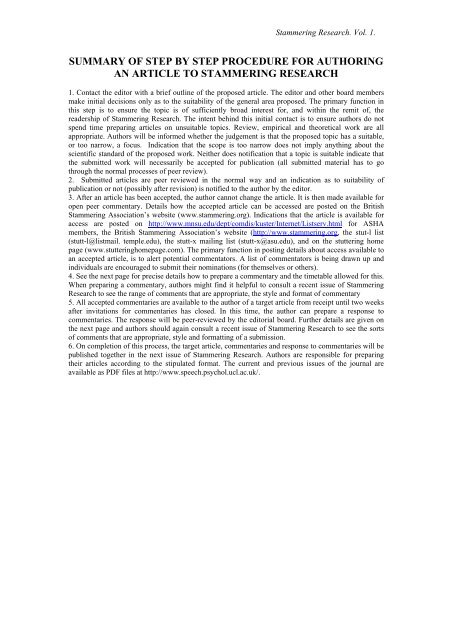Announcing 'Stammering Research' - Stammering Research - UCL
Announcing 'Stammering Research' - Stammering Research - UCL
Announcing 'Stammering Research' - Stammering Research - UCL
You also want an ePaper? Increase the reach of your titles
YUMPU automatically turns print PDFs into web optimized ePapers that Google loves.
<strong>Stammering</strong> <strong>Research</strong>. Vol. 1.<br />
SUMMARY OF STEP BY STEP PROCEDURE FOR AUTHORING<br />
AN ARTICLE TO STAMMERING RESEARCH<br />
1. Contact the editor with a brief outline of the proposed article. The editor and other board members<br />
make initial decisions only as to the suitability of the general area proposed. The primary function in<br />
this step is to ensure the topic is of sufficiently broad interest for, and within the remit of, the<br />
readership of <strong>Stammering</strong> <strong>Research</strong>. The intent behind this initial contact is to ensure authors do not<br />
spend time preparing articles on unsuitable topics. Review, empirical and theoretical work are all<br />
appropriate. Authors will be informed whether the judgement is that the proposed topic has a suitable,<br />
or too narrow, a focus. Indication that the scope is too narrow does not imply anything about the<br />
scientific standard of the proposed work. Neither does notification that a topic is suitable indicate that<br />
the submitted work will necessarily be accepted for publication (all submitted material has to go<br />
through the normal processes of peer review).<br />
2. Submitted articles are peer reviewed in the normal way and an indication as to suitability of<br />
publication or not (possibly after revision) is notified to the author by the editor.<br />
3. After an article has been accepted, the author cannot change the article. It is then made available for<br />
open peer commentary. Details how the accepted article can be accessed are posted on the British<br />
<strong>Stammering</strong> Association’s website (www.stammering.org). Indications that the article is available for<br />
access are posted on http://www.mnsu.edu/dept/comdis/kuster/Internet/Listserv.html for ASHA<br />
members, the British <strong>Stammering</strong> Association’s website (http://www.stammering.org, the stut-l list<br />
(stutt-l@listmail. temple.edu), the stutt-x mailing list (stutt-x@asu.edu), and on the stuttering home<br />
page (www.stutteringhomepage.com). The primary function in posting details about access available to<br />
an accepted article, is to alert potential commentators. A list of commentators is being drawn up and<br />
individuals are encouraged to submit their nominations (for themselves or others).<br />
4. See the next page for precise details how to prepare a commentary and the timetable allowed for this.<br />
When preparing a commentary, authors might find it helpful to consult a recent issue of <strong>Stammering</strong><br />
<strong>Research</strong> to see the range of comments that are appropriate, the style and format of commentary<br />
5. All accepted commentaries are available to the author of a target article from receipt until two weeks<br />
after invitations for commentaries has closed. In this time, the author can prepare a response to<br />
commentaries. The response will be peer-reviewed by the editorial board. Further details are given on<br />
the next page and authors should again consult a recent issue of <strong>Stammering</strong> <strong>Research</strong> to see the sorts<br />
of comments that are appropriate, style and formatting of a submission.<br />
6. On completion of this process, the target article, commentaries and response to commentaries will be<br />
published together in the next issue of <strong>Stammering</strong> <strong>Research</strong>. Authors are responsible for preparing<br />
their articles according to the stipulated format. The current and previous issues of the journal are<br />
available as PDF files at http://www.speech.psychol.ucl.ac.uk/.


